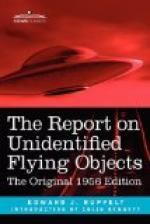For ten minutes the ground radar followed the chase. At times the unidentified target would slow down and the F-94 would start to close the gap, but always, just as the F-94 was getting within radar range, the target would put on a sudden burst of speed and pull away from the pursuing jet. The speed of the UFO—for by this time all concerned had decided that was what it was—couldn’t be measured too accurately because its bursts of speed were of such short duration; but on several occasions the UFO traveled about 4 miles in one ten-second sweep of the antenna, or about 1,400 miles an hour.
The F-94 was getting low on fuel, and the pilot had to break off the chase a minute or two before the UFO got out of range of the ground radar. The last few plots on the UFO weren’t too good but it looked as if the target slowed down to 200 to 300 miles an hour as soon as the F-94 turned around.
What was it? It obviously wasn’t a balloon or a meteor. It might have been another airplane except that in 1952 there was nothing flying, except a few experimental airplanes that were far from Michigan, that could so easily outdistance an F-94. Then there was the fact that radar clocked it at 1,400 miles an hour. The F-94 was heading straight for the star Capella, which is low on the horizon and is very brilliant, but what about the radar contacts? Some people said “Weather targets,” but the chances of a weather target’s making a 180-degree turn just as an airplane turns into it, giving a radar lock-on, then changing speed to stay just out of range of the airplane’s radar, and then slowing down when the airplane leaves is as close to nil as you can get.
What was it? A lot of people I knew were absolutely convinced this report was the key—the final proof. Even if all of the thousands of other UFO reports could be discarded on a technicality, this one couldn’t be. These people believed that this report in itself was proof enough to officially accept the fact that UFO’s were interplanetary spaceships. And when some people refused to believe even this report, the frustration was actually pitiful to see.




